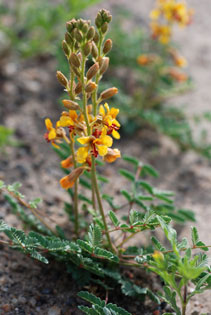INDIAN RUSH-PEA
|
 |
| File Size: 72 KB |
|
|
|
Hoffmannseggia glauca (Ortega ) Eifert
|
| Morton County, Kansas |
| Perennial |
| Height: 2-16 inches |
| Family: Fabaceae - Bean Family |
| Flowering Period: May, June, July, August, September |
|
| Also Called: | | Pignut, hog potato. | | Stems: | | Erect or spreading, simple or branched, glabrous or pubescent, glands on stalks above. | | Leaves: | | Alternate, mostly basal, odd twice pinnately compound; segment pairs 2-6 plus 1; leaflet pairs 6-11 per segment; leaflets nearly sessile, elliptic or oblong, 1/10 to 2/5 inch long, about 1/10 inch wide, minutely pubescent or nearly smooth, lower surface without orange glands. | | Inflorescences: | | Raceme, 4 to 8 inches long, 5-15-flowered, pubescent, glandular, terminal. | | Flowers: | | Stalks 1/10 to 1/5 inch long, pubescent, glandular; calyx 5-lobed, pubescent, glandular; lobes 1/4 inch long; petals 5, 2/5 to 1/2 inch long, yellowish-orange, claws glandular; stamens 10, separate, shorter than petals; filaments red, pubescent, glandular. | | Fruits: | | Pods, flat, 1/10 to 1/6 inch long, lustrous; seeds 2-8, ovate. | | Habitat: | | Prairies, fields, roadsides, stream valleys, disturbed areas; open alkaline sites; rocky or sandy soils. | | Distribution: | | Southwest 1/4 of Kansas. | | Forage Value: | | The underground tubers are eaten by hogs. | | Uses: | | Native Americans roasted and ate the underground tubers. | | Comments: | | An aggressive noxious weed in Kansas and other states. Named for Johann Centurius von Hoffmannsegg, 1766-1849, Count of Hoffmannsegg, Germany. |
|
| Indian rush-pea |  | | 62 KB | | Morton County, Kansas |
| | Indian rush-pea inflorescence |  | | 74 KB | | Morton County, Kansas |
| | Indian rush-pea flower |  | | 36 KB | | Morton County, Kansas |
| | Indian rush-pea flowers and stalked glands |  | | 48 KB | | Morton County, Kansas |
| | Indian rush-pea leaves |  | | 101 KB | | Morton County, Kansas |
|
|
|
|
|
|
|